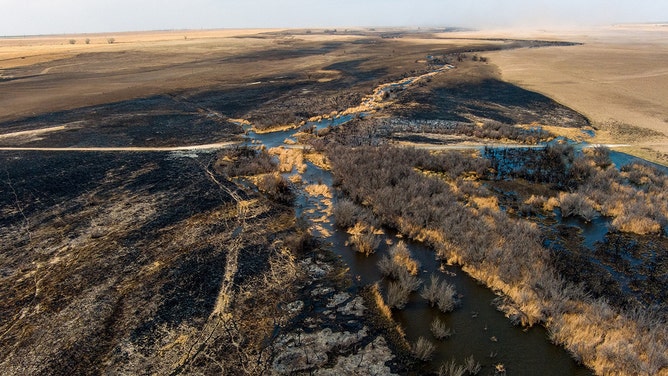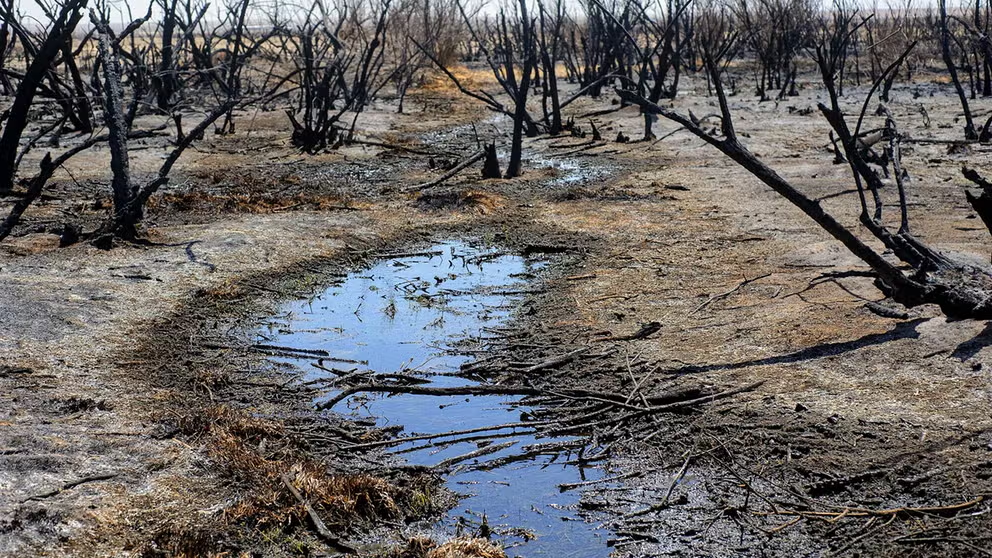Ranchers risk lives to save herds as 30-foot flames scorch Colorado 'tinderbox'
Acres upon acres of riparian and wetland habitat comprise the Lamar farmstead, home to many wildlife species – some listed on the threatened and endangered list
Colorado ranch loses livestock as thousands of acres burn in Sandy Creek Fire
Ranchers in southeast Colorado are recovering from a wildfire that tore through the area last Friday. One ranch in the town of Lamar -- the May Ranch -- lost livestock to the Sandy Creek Fire and thousands of acres were scorched.
LAMAR, Colo. – It was the perfect storm that scorched thousands of acres in southeastern Colorado, killing dozens of livestock in its aftermath. It could’ve been exponentially worse if it wasn't for a community of tight-knit ranchers.
Acres upon acres of riparian and wetland habitat comprise the May Ranch, a family farmstead in Lamar. It is home to many wildlife species, including some on the threatened and endangered list. Their cattle take the place of bison, which were hunted nearly to extinction and are an integral part of creating a diverse habitat that provides for all species.
"We operate an all-natural, grass-fed working ranch and depend on our cattle to support us economically while we strive to provide wildlife with the habitat they need to thrive," said Dallas May, the family's patriarch.
May Ranch in Lamar, Colorado, loses livestock, 9,500 acres due to Sandy Creek Fire
The May family said the Sandy Creek wildfire took some of their animals and thousands of acres of their land last Friday in Lamar, Colorado. They said they're lucky it wasn't worse.
The operation is owned and operated by May, his mother, sister and brother. He also has three grown children and five grandchildren who live and work on the ranch.
Last Friday, the May Ranch was under a Fire Weather Warning and expecting 70-mph winds or higher. The Mays began their day as they always do -- taking care of their cattle and feeding them.
"We were delivering feed when we received a call from a neighbor that there was a fire on the south end of our ranch, and the wind was blowing it directly into our Creek Valley," May said.

An aerial view of the May Cattle Ranch was taken on April 26, 2022, looking north along Big Sandy Creek near Lamar, Colo. An April 22 fire scorched 9,500 acres of the environmentally progressive property, destroying pastureland and wildlife habitat.
(Mike Sweeney / The Colorado Sun)
30-foot flames singe 9,500 acres
Family members immediately began to fight the fire with heavy equipment and made fire lines, which the blaze breached. Rescue efforts got underway to get every animal out of the path of the fire.
"We are extremely diligent and have a contingency plan in case of fire, but this one was so severe it overwhelmed every effort we had," May recalled.
Flames from the fire, later dubbed the Sandy Creek Fire, some 30 feet tall, shot into the sky and later spread to more than 9,500 acres.
HOW THE LAY OF THE LAND AFFECTS WILDFIRE BEHAVIOR
After it was apparent that May could not stop the fire, his family and every neighbor in their community began creating escape routes for all the cattle and wildlife in the path of the fire.
"We had many people who put their lives on the line and risk them to save every animal possible," May said. "Because the animals did not know where the safe places were to go, it was up to everybody to push them out of danger and into safe areas, which was extremely difficult."
An animal’s natural tendency is to run in front of the fire, and May said they could not outrun it.
"We don’t have a fire season anymore. Our fire season is 12 months a year, maybe 13 months a year -- the way it feels to us."
"They had to be pushed to the sides as the fire progressed," May said. "It was a monumental effort and is a testament to the spirit of our ranching community and our local law enforcement and volunteer fire departments."
May said he couldn’t even guess how many people came to his rescue with equipment and trailers full of horses to get between the fire and the animals.
A lack of cell phone service on the ranch was not an issue. Every person knew what needed doing and did it.
"Nobody stopped until every animal possible was rescued," May said. "Many people risked their lives to accomplish this."
THE FUTURE OF WILDFIRE DETECTION IS HERE: ARTIFICIAL INTELLIGENCE
However, not all was a success. There were heart-wrenching losses. Two mature cows died, and an unknown number of calves have yet to be found. In addition, a horse, 80 goats and 20 sheep were killed.
"This seems small until you consider the fact that there were 1,100 mature cattle in the direct path of the fire and an unknown number of babies because they are being born every day," May said.
It’s unknown what caused the fires, but they began in an open area underneath high-voltage transmission lines that cross May’s property.

Flames from the fire, later dubbed the Sandy Creek Fire, some 30 feet tall, shot into the sky and later spread to more than 9,000 acres.
(Mike Sweeney / The Colorado Sun)
‘We’re just a total tinderbox’
Drought has changed the eastern plains of Colorado a lot over the years.
May said that when the drought started he was told by people older than him that it would only last seven years.
"Well, 22 years into it, we’re trying to survive that seven-year drought," May said.
DROUGHT GOING FROM BAD TO WORSE ALONG COLORADO RIVER BASIN
Ranchers' livelihoods depend on being able to raise cattle and keep their habitat as good as it can be.
"We’re not different. We’re typical of every rancher," May said. "We try to make our place as good as it can be. We try to have enough habitat for the wildlife, habitat for our cattle."
What he has seen in the last two decades is becoming an impossible task because they have so much against them. He said typically, a fire like this would not have had the same intensity.
"But we are so dry, we’re just a total tinderbox," May said.
May said that because of the changing climate, he believes wildfires like this will become a year-round thing.
"We don’t have a fire season anymore," he said. "Our fire season is 12 months a year, maybe 13 months a year -- the way it feels to us."

Riley May (from left to right), gathers with his uncle, Bon May, father, Dallas May, and brother-in-law, Wesley Werth, after moving cattle to new pastures.
(Mike Sweeney / The Colorado Sun)
It's all about diligence
Almost a week later, they still have fires burning on the ranch. May said he is worried that any change in the wind could blow embers into areas where the cattle have been moved, putting them back into crisis mode.
"It’s just a matter of being diligent," May said. "We have so many people in our local area that are working with us."
HOW WILDFIRE BURN SCARS COULD HAVE LASTING IMPACTS
The ranching and agriculture community in Lamar put their lives on the line to save the lives of animals.
"If we have a fire today, or a neighboring ranch has a fire today, the same response will go through," May said.
So when the next perfect storm rolls through, these Colorado ranchers will do everything possible to help each other extinguish the flames.

